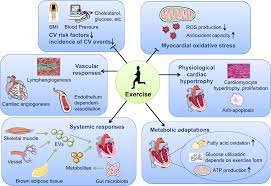Introduction
Cardio exercises, short for cardiovascular exercises, constitute a vital aspect of a healthy lifestyle. These activities focus on elevating heart rate and enhancing overall cardiovascular health. In this article, we’ll explore the definition of cardio exercises and delve into their immense benefits, different types, and how to seamlessly incorporate them into your fitness routine.
Benefits of Cardio Exercises
Heart Health
Cardio exercises play a pivotal role in fortifying the heart, reducing the risk of heart diseases, and promoting overall cardiovascular well-being. The increased efficiency in pumping blood ensures a healthy heart that functions optimally.
Weight Management
For individuals seeking weight control, cardio exercises are indispensable. These activities facilitate calorie burn, aiding in weight loss or maintenance. Additionally, they contribute to an accelerated metabolism, simplifying weight management.
Improved Mood and Mental Health
Engaging in cardio activities triggers the release of endorphins, commonly known as “feel-good” hormones. This not only reduces stress, anxiety, and depression but also fosters a positive and balanced mental state.
Enhanced Lung Capacity
The demand for increased oxygen during cardio exercises leads to improved lung capacity over time. This strengthened respiratory system contributes to better overall health.
Types of Cardio Exercises
Low-Impact Options
1. Brisk Walking
Brisk walking is a low-impact cardio exercise accessible to individuals of all fitness levels. It provides an excellent introduction to cardiovascular activities, promoting heart health without excessive strain on joints.
2. Swimming
Swimming is another low-impact option that engages multiple muscle groups while being gentle on the joints. It is particularly beneficial for those with joint issues or injuries.
Moderate-Intensity Activities
1. Jogging
Jogging serves as a moderate-intensity cardio exercise that can be adapted to various fitness levels. It enhances cardiovascular health and contributes to weight management.
2. Cycling
Cycling is a versatile moderate-intensity activity suitable for beginners and seasoned enthusiasts alike. It offers a joint-friendly option while delivering excellent cardiovascular benefits.
High-Intensity Interval Training (HIIT)
1. Overview
High-Intensity Interval Training (HIIT) involves alternating between short bursts of intense activity and brief periods of rest or lower-intensity exercise. This approach maximizes calorie burn and cardiovascular benefits in a shorter time frame.
2. Benefits
HIIT not only improves cardiovascular health but also enhances metabolism, promoting efficient calorie burn even after the workout session concludes.
How to Start a Cardio Routine
Setting Realistic Goals
Establishing achievable goals is crucial when initiating a cardio routine. Realistic objectives keep motivation high and pave the way for gradual progress.
Choosing Suitable Activities
Selecting activities that align with personal preferences and fitness levels increases the likelihood of adherence to a cardio routine. Variety adds an element of excitement and helps prevent monotony.
Gradual Progression
Begin with manageable intensity and duration, gradually increasing both as fitness improves. This approach minimizes the risk of injury and allows the body to adapt to the demands of cardio exercises.
Staying Consistent
Consistency is key to reaping the full benefits of cardio exercises. Establishing a regular routine enhances cardiovascular health and contributes to overall well-being.
Cardio Exercises for Different Fitness Levels
Beginners
For beginners, low-impact activities such as brisk walking, stationary cycling, or water aerobics are ideal starting points. These activities provide a gentle introduction to cardiovascular exercise, allowing individuals to build stamina gradually.
Intermediate
Intermediate fitness enthusiasts can explore activities like running, swimming, or group fitness classes. These options offer a balance between intensity and sustainability, promoting ongoing cardiovascular health.
Advanced
Advanced individuals may incorporate high-intensity options like sprinting, advanced HIIT workouts, or intense cycling sessions. These activities challenge cardiovascular endurance and contribute to peak fitness levels.

Common Mistakes to Avoid
Overtraining
Excessive cardio without adequate rest can lead to overtraining, causing fatigue, increased injury risk, and decreased performance. Balancing intensity with sufficient recovery is crucial.
Ignoring Warm-up and Cool-down
Neglecting warm-up and cool-down routines can result in injuries and decreased flexibility. Incorporating these practices prepares the body for exercise and aids in muscle recovery post-workout.
Lack of Variety
Repeating the same cardio exercises without variety can lead to plateaus and boredom. Introducing diverse activities not only targets different muscle groups but also keeps workouts interesting.
Combining Cardio with Strength Training
Synergistic Benefits
Integrating cardio with strength training creates a comprehensive fitness routine. Cardiovascular exercises enhance endurance, while strength training builds muscle mass and boosts metabolism.
Sample Workouts
A sample workout could include alternating days of cardio and strength training or combining both elements within a single session. This approach maximizes efficiency and overall fitness gains.
Cardio and Weight Loss
Caloric Burn
Cardio exercises contribute significantly to caloric burn, aiding in weight loss. Combining these activities with a balanced diet creates a synergistic approach to achieving and maintaining a healthy weight.
Best Practices
Incorporating a mix of cardio exercises, along with resistance training and a well-balanced diet, ensures a holistic approach to weight loss. Consistency and patience are key to sustainable results.
Cardiovascular Health and Aging
Importance of Cardio in Older Adults
Cardio exercises are crucial for maintaining cardiovascular health in older adults. Tailoring activities to individual fitness levels ensures safety while promoting overall well-being.
Modified Exercises for Seniors
Low-impact options like walking, swimming, or gentle aerobics are suitable for seniors. Modifications can be made to accommodate any physical limitations, ensuring a safe and effective workout routine.
Cardio Exercises at Home
Bodyweight Workouts
Home-based cardio exercises using bodyweight, such as jumping jacks, burpees, or mountain climbers, provide effective options for those unable to access a gym.
Virtual Classes
Online platforms offer a myriad of virtual cardio classes, allowing individuals to engage in guided workouts from the comfort of their homes. These classes cater to various fitness levels and preferences.

Overcoming Cardio Exercise Plateaus
Recognizing Plateaus
Plateaus occur when the body adapts to a particular exercise routine, leading to diminished results. Recognizing signs of plateauing is essential for adjusting and reinvigorating the workout regimen.
Strategies for Progress
To overcome plateaus, consider adjusting workout intensity, incorporating new activities, or modifying existing routines. This approach challenges the body, fostering continued improvement.
Tracking Progress
Importance of Monitoring
Tracking progress provides tangible evidence of improvements in cardiovascular fitness. Utilize tools like fitness apps or journals to log workouts, monitor milestones, and stay motivated.
Tools and Apps
Various fitness apps offer features for tracking cardio workouts, setting goals, and providing real-time feedback. Leveraging these tools enhances the overall cardio exercise experience.
Common Cardio Myths
Spot Reduction
The myth of spot reduction, targeting fat loss in specific areas through localized exercises, is debunked. Cardio exercises contribute to overall fat loss, not isolated reduction in specific body parts.
Cardio and Muscle Loss
Contrary to a common misconception, moderate cardio does not necessarily lead to muscle loss. Proper nutrition and a balanced exercise routine can preserve and even build muscle mass.
Expert Advice
Recommendations from Fitness Professionals
Fitness professionals advocate for a balanced approach to cardio, emphasizing variety, consistency, and gradual progression. Tailoring workouts to individual needs enhances overall effectiveness.
Real-Life Success Stories
Transformations Through Cardio
Highlighting real-life success stories showcases the transformative power of cardio exercises. These stories inspire and motivate individuals to embark on their own fitness journey.
Conclusion
In conclusion, cardio exercises are the cornerstone of a healthy lifestyle, offering a plethora of benefits for heart health, weight management, and overall well-being. Whether you’re a beginner or an advanced fitness enthusiast, there are diverse options to suit your preferences and fitness levels. Avoiding common mistakes, incorporating variety, and combining cardio with strength training create a holistic approach to fitness. By dispelling myths and embracing expert advice, individuals can embark on a journey toward improved cardiovascular health.
FAQs
- How often should I engage in cardio exercises for optimal results? Engaging in cardio exercises at least three to five times per week is recommended for optimal cardiovascular benefits. However, the frequency can vary based on individual goals and fitness levels.
- Can I solely rely on cardio for weight loss? While cardio contributes to weight loss by burning calories, a balanced approach that includes strength training and a healthy diet is more effective for sustainable weight management.
- Are high-intensity cardio workouts suitable for everyone? High-intensity cardio workouts may not be suitable for beginners or individuals with certain health conditions. It’s essential to consult with a healthcare professional before starting any intense exercise regimen.
- What is the best time of day to do cardio exercises? The best time to do cardio exercises is subjective and depends on individual preferences and schedules. Some people prefer morning workouts for an energy boost, while others find evening workouts more convenient.
- How can I stay motivated to continue my cardio routine? Staying motivated involves setting realistic goals, incorporating variety into your workouts, and celebrating small victories. Finding activities you enjoy and enlisting a workout buddy can also enhance motivation.


